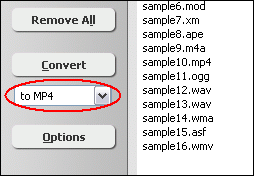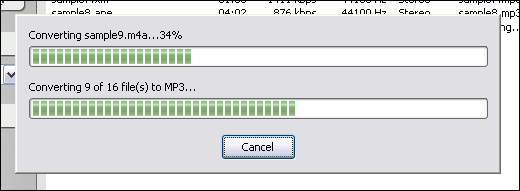WAVE64 to MP4Convert WAVE64 to MP4, WAVE64 to MP4 Converter |
 |
| Home | Getting Started | Download | Buy Now! | Screen Shots | FAQ | Support | Contact |
MP4 MP3 Converter converts WAVE64 files to MP4 format. The software is an all in one audio converter that supports more than 100 audio and video files. MP4 MP3 Converter also supports batch conversion, and is full compatible with Vista and Windows 7.
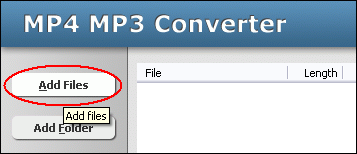 Click "Add Files" button to choose WAVE64 files and add them to conversion list. 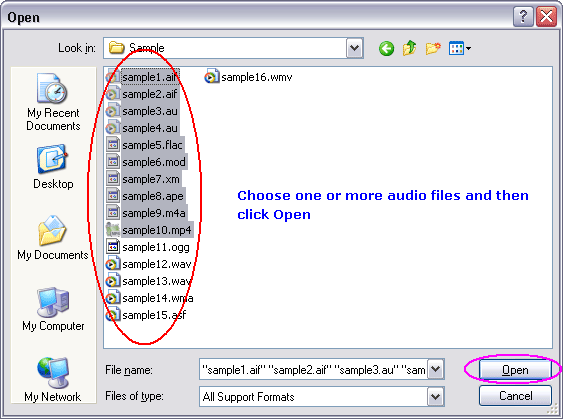 Choose one or more WAVE64 files you want to convert and then click "Open". 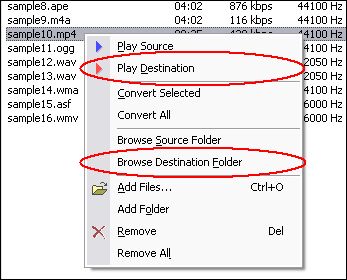 Right-click converted item and choose "Play Destination" to play the destination file, choose "Browse Destination Folder" to open Windows Explorer to browse the destination file. What is WAVE64? The Sony Wave64 file format is defined as a true 64 bit file format that allows to overcome the limitations of the RIFF/WAVE format. The file format was originally defined by Sonic Foundry. In Summer 2003, Sony Pictures Digital acquired Sonic Foundry's Desktop Software assets. Since then, the new format is officially promoted as Sony Pictures Digital Wave 64. Companies are encouraged to support this format and no royalties have to be paid to use it. The Sony Wave64 file format is very similar to the well known RIFF/WAVE format. Therefore, existing software implementations of RIFF/WAVE file filters are likely to be extendable to support the Sony Wave64 file format with little programming effort. Because of the similarities to the RIFF/WAVE format, only the differences between these formats are described. It is assumed that the reader is familiar with the original format as defined by Microsoft. What is MP4? MPEG-4 is a patented collection of methods defining compression of audio and visual (AV) digital data. It was introduced in late 1998 and designated a standard for a group of audio and video coding formats and related technology agreed upon by the ISO/IEC Moving Picture Experts Group (MPEG) (ISO/IEC JTC1/SC29/WG11) under the formal standard ISO/IEC 14496 - Coding of audio-visual objects. Uses of MPEG-4 include compression of AV data for web (streaming media) and CD distribution, voice (telephone, videophone) and broadcast television applications. MPEG-4 absorbs many of the features of MPEG-1 and MPEG-2 and other related standards, adding new features such as (extended) VRML support for 3D rendering, object-oriented composite files (including audio, video and VRML objects), support for externally-specified Digital Rights Management and various types of interactivity. AAC (Advanced Audio Coding) was standardized as an adjunct to MPEG-2 (as Part 7) before MPEG-4 was issued. MPEG-4 is still a developing standard and is divided into a number of parts. Companies promoting MPEG-4 compatibility do not always clearly state which "part" level compatibility they are referring to. The key parts to be aware of are MPEG-4 part 2 (including Advanced Simple Profile, used by codecs such as DivX, Xvid, Nero Digital and 3ivx and by Quicktime 6) and MPEG-4 part 10 (MPEG-4 AVC/H.264 or Advanced Video Coding, used by the x264 encoder, by Nero Digital AVC, by Quicktime 7, and by high-definition video media like Blu-ray Disc). Convert WAVE64 to MP4 Related Topics: MP3 to MP4, AAC to MP4, ALAW to MP4, CDA to MP4, OGA to MP4, ALAC to MP4, F4A to MP4, WAV to MP4, M4A to MP4, F4B to MP4, CAF to MP4, MKA to MP4, M4V to MP3, MOD to MP4, QCP to MP4, ADX to MP4, UMX to MP4, W64 to MP4, MTM to MP4, IT to MP4, NSA to MP4, MLP to MP4, WMA to MP4, FLAC to MP4, M4B to MP4, MMF to MP4, SPX to MP4, MPC to MP4, AIFF to MP4, M4V to M4A, ULAW to MP4, XM to MP4, M2A to MP4, MO3 to MP4, MXF to MP4
|
| Home | Getting Started | Download | Buy Now! | Screen Shots | FAQ | Support | Contact | Links |
| Copyright © 2008-2013 Hoo Technologies All rights reserved. Privacy Policy |
